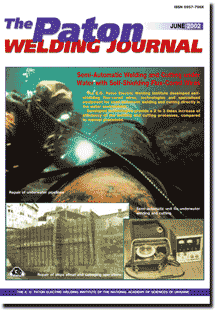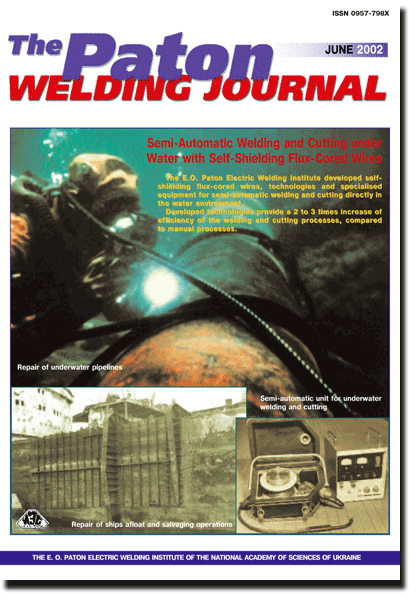

(You are viewing the simplified file contents)
AS = «Automatic Welding» - 6 issues per year;
TPWJ = «PATON WELDING JOURNAL» - 12 issues per year;
SEM = «Electrometallurgy Today» - 4 issues per year;
TDNK = «Technical Diagnostics and Non-Destructive Testing» - 4 issues per year.


| SCIENTIFIC AND TECHNICAL | |
| Kuchuk-Yatsenko S.I., Zyakhor I.V. and Gordan G.N.
Effect of process parameters and braking dynamics in friction welding on structure and properties of joints between copper and aluminium | 2 |
| The technology for friction welding with a regulated braking has been developed. It provides joints with high strength and ductility values, containing no intermetallic layer. The use of the new technology allows technological capabilities of standard friction welding equipment to be expanded. | |
| Efimenko N.G.
Modifying, refining and alloying with yttrium in welding of steels. | 8 |
| Refining, modifying and alloying effect of yttrium in cast steel 30 was substantiated using advanced procedures. Mechanism of yttrium effect on cold resistance of pearlitic steels and their welded joints is specified. | |
| Pinchuk N.I., Ryazanstev N.K. and Rovensky I.L.
Welded joints of austenitc steel 25Cr-20Ni-2Si in augmented turbopiston engines. | 13 |
| Experimental data are given on prevention of hot cracks in dissimilar welded joints of high-silicon 25Cr-20Ni-2Si steel with 10Kh18N10T steel and KhN65MTYu nickel alloy. It is shown that alloying of weld metal with boron in the amount of 0.45-0.80 % improves the technological strength of welds. | |
| Skripka N.N.
Structure and properties of nickel-based alloy deposited by laser-powder method. | 18 |
| Structure and properties of Ni-based deposited layer produced by a laser-powder surfacing were examined. It was established that it possible to produce coatings with a microcrystalline, amorphous-crystalline or amorphous structure depending on the surfacing technological conditions. Test on corrosion resistance and wear were performed. It was found that it is rational to use the deposited layers with amorphous-crystalline structure for the parts operating in aggressive media and in the conditions of abrasive wear. | |
| Tarasov N.M., Gorlov A.K. and Lashko S.N.
Numerical modelling of the process of formation of a molten metal drop at the tip of a consumable electrode. | 21 |
| The paper describes a numerical method of determination of the weight and mean temperature of the drop at the tip of a consumable electrode in arc welding. Changes in thermophysical characteristics of a material, availability of phase transitions and programmed change of arc current are taken into account. Calculation data for drops of copper, titanium, and aluminium coincide with the experiment with the accuracy commensurate with experimental error. Programmed variation of arc current widens the capability of adjustment of temperature and weight of the molten metal drops. | |
| INDUSTRIAL | |
| Shelyagin V.D. and Khaskin V.Yu.
Tendencies in development of laser-arc welding (Review). | 25 |
| Dynamics and subject-oriented nature of scientific publications on hybrid and combined laser-arc processes and methods to develop them, based on current promising welding technologies, are described. Comparison of laser-arc and laser welding is made. Selection of the area of further research is substantiated. | |
| Sidoruk V.S. and Galinich V.I.
Classification of fluxes for arc welding by metallurgical and technological properties | 29 |
| Updated classification of welding fluxes by metallurgical and technological properties, kind of welding current and other features, is offered. The comprehensive system of flux coding with allowance for different characteristics is described. | |
| Vasilkov V.I., Kislitsky A.A., Onuchin N.V., Pchelkin R.D., Rozhkov V.V., Ushakov A.V., Strukov A.V., Rempe N.G. and Osipov I.V.
Experience of using guns with plasma cathodes for electron beam welding of nuclear power station fuel elements. | 33 |
| Data are given on commercial application of electron beam guns with plasma cathodes for welding zirconium and aluminium alloys. Design peculiarities of plasma sources of electrons and their advantages are considered. Many-year experience accumulated in the field of sealing the nuclear power station fuel elements by EBW shows a promising future of using the plasma-cathode electron guns for these purposes. The guns are simple in service and reliable in operation under complicated vacuum conditions. | |
| Lebedev V.A. and Pichak V.G.
Mechanized equipment for welding, hardfacing and cutting in the field conditions | 35 |
| Feasibility of use of the arc mechanized processes in the field conditions is considered. It was found that welding units with internal combustion engines can be used in this case as arc supply sources for the semi-automatic machines. Accumulators with a series-parallel connection are offered as a stable power source for supply of the electric circuit elements. Diagram of connection of the power source for the semi-automatic machine systems with a definite algorithm of accumulators switching (for their charging and service in devices of the mechanized arc equipment) has been developed. | |
| BRIEF INFORMATION | |
| Tsybulkin G.A.
About effect of electric field fluctuations in arc column on arc welding process stability. | 38 |
| A sufficient condition has been obtained guaranteeing the asymptotic stability of the consumable electrode arc welding process in the case when the electric field intensity in the arc column varies within certain known limits. | |
| NEWS | |
| International Exhibition "Welding - Ukraine'2002". | 40 |
| V.K. Lebedev is 80. | 45 |
(You are viewing the simplified file contents)
The cost of subscription/purchase order journals or individual articles
| Journal/Currency | Annual Set | 1 issue printed |
1 issue |
one article |
| AS/UAH | 1800 UAH | 300 UAH | 300 UAH | 150 UAH |
| AS/USD | 192 $ | 32 $ | 26 $ | 16 $ |
| AS/EUR | 180 € | 30 € | 25 € | 15 € |
| TPWJ/UAH | 7200 UAH | 600 UAH | 600 UAH | 280 UAH |
| TPWJ/USD | 384 $ | 32 $ | 26 $ | 16 $ |
| TPWJ/EUR | 360 € | 30 € | 25 € | 15 € |
| SEM/UAH | 1200 UAH | 300 UAH | 300 UAH | 150 UAH |
| SEM/USD | 128 $ | 32 $ | 26 $ | 16 $ |
| SEM/EUR | 120 € | 30 € | 25 € | 15 € |
| TDNK/UAH | 1200 UAH | 300 UAH | 300 UAH | 150 UAH |
| TDNK/USD | 128 $ | 32 $ | 26 $ | 16 $ |
| TDNK/EUR | 120 € | 30 € | 25 € | 15 € |
AS = «Automatic Welding» - 6 issues per year;
TPWJ = «PATON WELDING JOURNAL» - 12 issues per year;
SEM = «Electrometallurgy Today» - 4 issues per year;
TDNK = «Technical Diagnostics and Non-Destructive Testing» - 4 issues per year.

